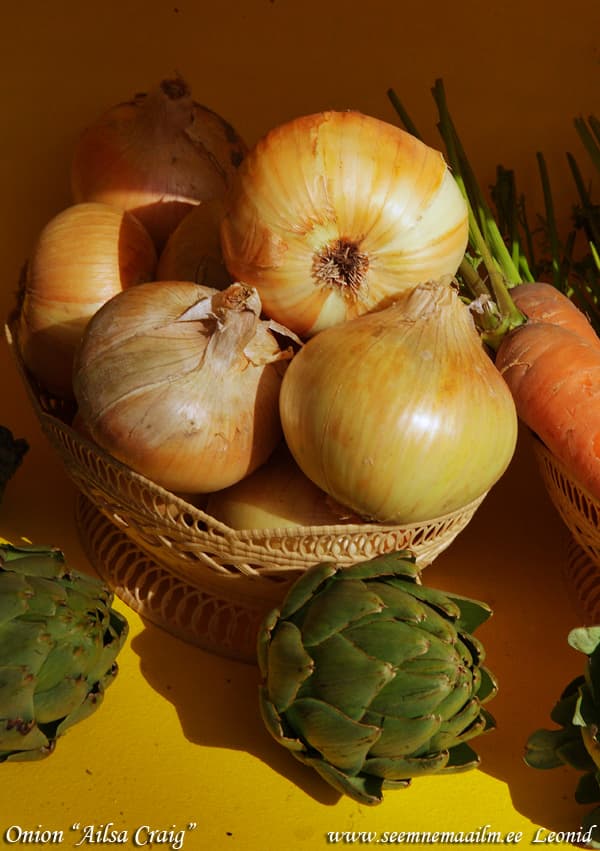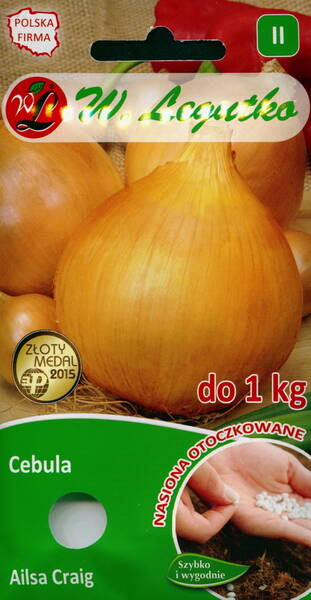The sweet taste and delicate aroma of this onion will ennoble even the simplest dish! Appreciate in full measure its advantages both fresh and after culinary processing.
The seeds produce massive bulbs that can weigh up to 250-450 grams each. Sowing and growing these giant onions is definitely well worth the effort.
A splendid exhibition variety of golden merit producing large globe shaped onions with a rich, golden straw coloured skin.
As well as being a super show variety, it is also one of the best varieties for general cultivation producing large onions with an excellent mild flavour. Can also be autumn sown.
Sowing Instructions: sow during mid-late winter in a good seed compost, just covering the seed with compost. Germination takes 14-21 days at +19+21°C. Higher temperatures may prevent germination.
Growing Instructions: transplant seedlings when 36 mm high into 9 cm pots. Making sure the tiny bulb is not covered. When well rooted move to a cold frame and plant out in early spring at 38 cm apart in a sunny spot in a rich fertile soil which has had plenty of well rotted compost dug in the previous autumn, and a dressing of general fertiliser at 4oz/sq. yd applied just before planting.
Aftercare Instructions: keep the soil moist during dry spells. As the leaves start to yellow bend over the tops, leave 14 days then lift and store when thoroughly ripened.

Hibernal onion.
* It is necessary to grow onions during winter sowing and planting in areas that are not flooded by spring flood waters, with fertile, weed-free soils that have a soil solution reaction close to neutral (pH 6-7). A prerequisite is constant illumination of the area throughout the day. Shading of plants, even by weeds, should not be allowed. It is also necessary to provide for the possibility of watering.
In the fall, 5-6 kg of rotted manure or compost, 0.5-2 kg of lime materials or ash, as well as 50 g of nitrophoska are added for digging (per 1 sq. m). Seeds are sown on beds 1 m wide and 15-20 cm high according to multi-line patterns with a distance between lines of 15-25 cm. The sowing rate for winter is 1-1.5 g per 1 sq. m. m, embedment depth – 1.5-2 cm.
Before winter, only dry seeds are sown, calculating the sowing time so that they do not germinate before the onset of stable cold weather. It is advisable to mulch the crops with peat or humus (1-2 cm layer), but not with sawdust. After emergence, the seedlings are weeded, the rows are systematically (after 7-10 days) loosened to a depth of 5-6 cm, preventing the soil from falling on the plants, and if necessary, watered.
In the phase of one true leaf, onions are fed at the rate of 10 g per 1 square meter of ammonium nitrate and potassium sulfate, and a month later - nitrophoska (50 g per 1 sq. m). In the phase of 4-5 leaves, foliar feeding is given (0.5 g per 1 sq. m of the drug, dissolved in 60 ml of water).
Onions are harvested when there is massive lodging of leaves.
When sown in winter, bulbs ripen 18-20 days earlier than in spring, and the turnip onion yield is 20-35% higher (and is stored better). When planting the small fraction of onion sets (less than 1 cm in diameter), before winter, the plants grown from them do not shoot and produce a high yield of large, well-ripened, long-lasting bulbs. They ripen 15-30 days earlier than when planting onion sets in spring. Moreover, each plant grown from small sets usually forms one bulb, regardless of the diversity of the variety. Therefore, all varieties zoned for this zone are suitable for winter cultivation.
The planting time in Estonia is early October, so that before the onset of persistent cold weather the bulbs take root, but do not germinate. In the fall, ridges 1 m wide and 15-20 cm high are prepared in a highly fertile area that is not flooded during spring floods.












